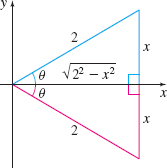EXAMPLE 1Finding an Integral Containing √4−x2
Find ∫dxx2√4−x2.
We exclude θ=−π2 and θ=π2 because they lead to x=±2, resulting in √4−x2=0.
Solution The integrand contains the square root √4−x2 that is of the form √a2−x2, where a=2. We use the substitution x=2sinθ, −π2<θ<π2. Then dx=2cosθdθ. Since √4−x2=↑x=2sinθ√4−4sin2θ=2√1−sin2θ=2√cos2θ=↑cos θ>0 since−π2<θ<π22cosθ
we have ∫dxx2√4−x2=∫2cosθdθ(4sin2θ)(2cosθ)=∫dθ4sin2θ=14∫csc2θdθ=−14cotθ+C
The original integral is a function of x, but the solution above is a function of θ. To express cotθ in terms of x, refer to the right triangles drawn in Figure 4.

Figure 4 sinθ=x2, −π2<θ<π2
Using the Pythagorean Theorem, the third side of each triangle is √22−x2=√4−x2. So, cotθ=√4−x2x−π2<θ<π2
Then ∫dxx2√4−x2=−14cotθ+C=−14√4−x2x+C=−√4−x24x+C